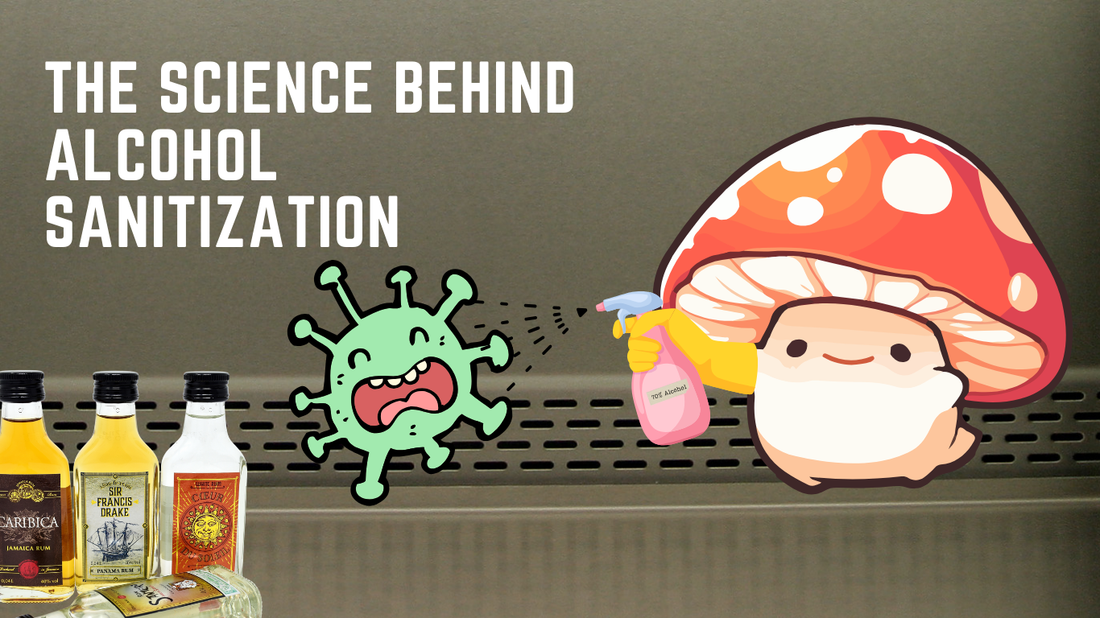
The Science Behind Alcohol Sanitization
Share
Maintaining a sterile workspace is the bedrock of successful mushroom cultivation. Among the various disinfectants available, 70% isopropyl or ethanol reigns supreme for its rapid, broad‑spectrum action. But what really happens at the cellular level when you wipe down your tools or workbench? In this post, we’ll explore the three complementary ways alcohol inactivates microbes—protein denaturation, membrane disruption, and desiccation—and share practical tips for applying them in your grow operation.
1. Protein Denaturation: The Knockout Punch
Proteins are the engines of all microbial life—catalyzing reactions, transporting nutrients, and giving cells their structure. Alcohol deals a swift blow by:
Breaking hydrogen bonds: Alcohol molecules interfere with the weak forces holding proteins in their precise 3D shapes.
Unraveling protein structure: As proteins lose their form, they can no longer function as enzymes, transporters, or support structures.
Irreversible damage: Denatured proteins rarely refold correctly, so even “injured” cells cannot recover.
Within seconds of contact, microbes lose the ability to carry out essential processes, effectively knocking them out of the competition.
2. Membrane Disruption: Tearing Down the Walls
Every microbial cell is guarded by a lipid membrane that controls nutrient flow and waste removal. Alcohol’s solvent properties let it:
Dissolve membrane lipids: By inserting itself into the phospholipid bilayer, alcohol creates pores and weak spots.
Cause cytoplasmic leakage: Once the membrane is breached, ions and vital molecules escape, and the cell collapses.
Amplify denaturation: With the barrier down, alcohol seeps in to attack internal proteins even faster.
Together, membrane disruption and protein denaturation form a lethal one‑two punch that leaves microbes no chance to survive.
3. Desiccation: The Finishing Move
Often misunderstood as alcohol’s main action, desiccation—or drying—actually plays a supporting, but crucial, role:
Water removal: Alcohol is hygroscopic, so as it evaporates it draws moisture out of cells.
Cellular collapse: Dehydrated cells shrink and lose osmotic balance, concentrating toxic byproducts.
Blocking recovery: Any survivors of the initial assault are left too parched to repair and reproduce.
For maximum effect, allow surfaces and tools to air‑dry rather than wiping them off immediately—this ensures desiccation has time to do its part.
Why 70% Alcohol Hits the Sweet Spot
You might be tempted to reach for pure (100%) alcohol, but most labs stick with 60–80% solutions because:
Optimal contact time: The water content slows evaporation, keeping alcohol in contact with microbes longer.
Deeper penetration: Water helps carry alcohol molecules into the cell before they evaporate.
Complete kill: Pure alcohol can coagulate surface proteins too quickly, forming a shield that protects inner structures.
A balanced 70% mix ensures proteins fully denature, membranes rupture, and desiccation seals the deal.
Best Practices for Alcohol Sanitization
-
Clean first, sanitize second: Remove dirt, dust, and organic residue—alcohol can’t penetrate grime.
-
Use the right concentration: Stick to 60–80% isopropyl or ethanol for best results.
-
Maintain wet contact: Aim for 15–30 seconds of wetness before air‑drying.
-
Let it air‑dry: Don’t wipe away the alcohol; let evaporation complete the process.
-
Combine with good technique: Work in a laminar flow hood or still‑air box, wear gloves and a mask, and minimize air disturbances.
In Summary
Alcohol’s power in mushroom cultivation comes from its three‑pronged attack:
-
Protein denaturation delivers the first knockout.
-
Membrane disruption collapses cell defenses.
-
Desiccation ensures no weakened survivors bounce back.
By understanding and applying these principles—especially with a 70% solution and sufficient contact time—you’ll keep contaminants at bay and give your mycelium the clean environment it needs to flourish.
Stay sterile, stay curious, and happy cultivating!
